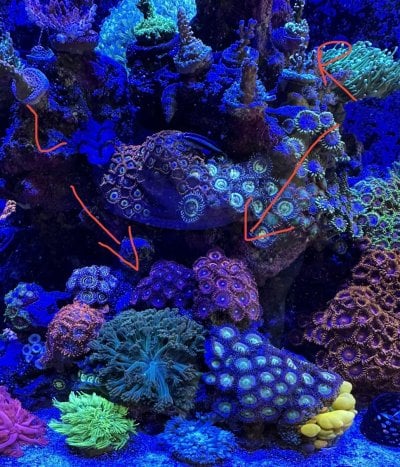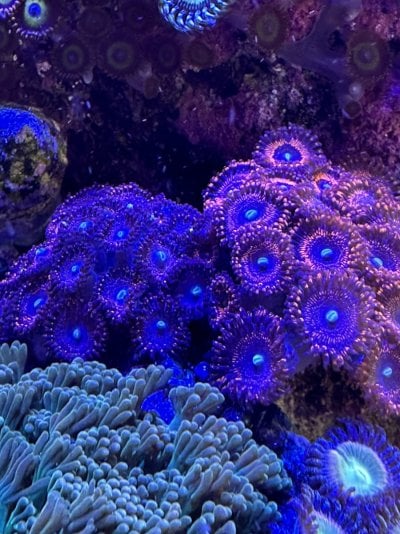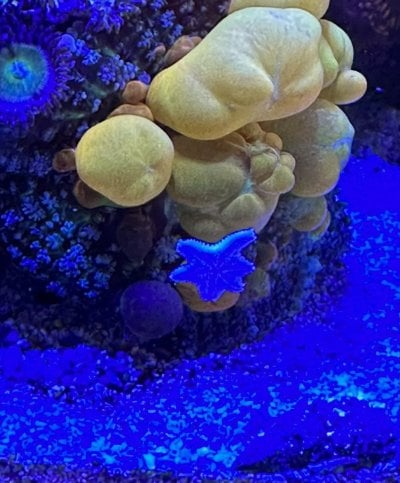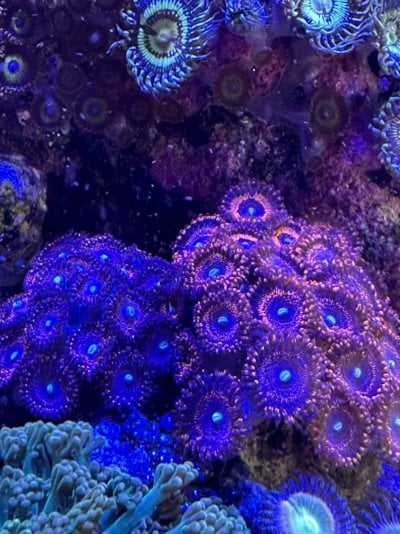Interesting perspective
After noticing an “asterina” starfish (I actually believe the are a different species) population starting to grow in a 1.5 year old mixed reef - I kept a close eye on my 2 colonies of illuminati zoas (as I started to see the asterinas sitting on zoas)
I was able to see 1 asterina star sitting on top of the Illuminati colony to the left that would move from polyp to polyp over the course of about 2 weeks while the Illuminati colony on the right remained completely free of asterinas
Since they are the same exact species of zoa , same size , same age , and from the same mother colony (as well as they are in the same tank conditions / par etc)
It was interesting to see what the actual effect of the asterina on the zoa was
These photos are from today (the left side Zoa has so far had a few weeks to start healing) as the asterina left once it was finished sitting on each polyp of the colony
But basically when the asterina had just finished sitting on the colony …. And moved off it , the zoas looked really bad , they had lost a lot of color (seemed to also have lost their lashes) and the stalks were shriveled up / the zoas lost a lot of size overall , all became sickly looking / etc while the exact same colony on the right (with no asterina) had no issues
So my conclusion is based on this limited comparison is , that these asterinas done eat the entire zoa , but they do some sort of damage , maybe eating parts of it which could in theory cause a colony to melt or other unforeseen issues
Last photo is the “asterina”




After noticing an “asterina” starfish (I actually believe the are a different species) population starting to grow in a 1.5 year old mixed reef - I kept a close eye on my 2 colonies of illuminati zoas (as I started to see the asterinas sitting on zoas)
I was able to see 1 asterina star sitting on top of the Illuminati colony to the left that would move from polyp to polyp over the course of about 2 weeks while the Illuminati colony on the right remained completely free of asterinas
Since they are the same exact species of zoa , same size , same age , and from the same mother colony (as well as they are in the same tank conditions / par etc)
It was interesting to see what the actual effect of the asterina on the zoa was
These photos are from today (the left side Zoa has so far had a few weeks to start healing) as the asterina left once it was finished sitting on each polyp of the colony
But basically when the asterina had just finished sitting on the colony …. And moved off it , the zoas looked really bad , they had lost a lot of color (seemed to also have lost their lashes) and the stalks were shriveled up / the zoas lost a lot of size overall , all became sickly looking / etc while the exact same colony on the right (with no asterina) had no issues
So my conclusion is based on this limited comparison is , that these asterinas done eat the entire zoa , but they do some sort of damage , maybe eating parts of it which could in theory cause a colony to melt or other unforeseen issues
Last photo is the “asterina”




















